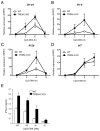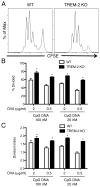TREM-2, triggering receptor expressed on myeloid cell-2, negatively regulates TLR responses in dendritic cells
- PMID: 21956652
- PMCID: PMC3444819
- DOI: 10.1002/eji.201141679
TREM-2, triggering receptor expressed on myeloid cell-2, negatively regulates TLR responses in dendritic cells
Abstract
DCs play a key role in defense against infections and also in preventing inflammatory and autoimmune diseases. The response of DCs to pathogens is tightly regulated by many mechanisms to allow for appropriate, but not pathogenic, responses. We previously showed that DCs with deficiencies for two ITAM-bearing signaling adapters, DAP12 and FcRγ, produce more inflammatory cytokines upon treatment with Toll-like receptor (TLR) agonists than WT DCs. Here, we investigated whether the TREM-2 receptor pairs with DAP12 to inhibit TLR responses in DCs. TREM-2-deficient BMDCs showed increased inflammatory cytokine and type I IFN production in response to TLR ligation. Additionally, TREM-2-deficient BMDCs had increased TLR-induced maturation and were more efficient at inducing antigen-specific T-cell proliferation upon CpG DNA stimulation compared with WT BMDCs. Finally, we showed that a TREM-2 ligand is expressed on the surface of BMDCs, suggesting that the TREM-2 receptor transduces inhibitory signals due to recognition of an endogenous ligand.
Copyright © 2012 WILEY-VCH Verlag GmbH & Co. KGaA, Weinheim.
Conflict of interest statement
The authors declare no financial or commercial conflict of interest.
Figures







References
-
- Banchereau J, Steinman RM. Dendritic cells and the control of immunity. Nature. 1998;392:245–252. - PubMed
-
- Janeway CA, Medzhitov R. Innate immune recognition. Annu Rev Immunol. 2002;20:197–216. - PubMed
-
- Steinman R, Hawiger D, Liu K, Bonifaz L, Bonnyay D, Mahnke K, Iyoda T, Ravetch J, Dhodapkar M, Inaba K, Nussenzweig M. Dendritic cell function in vivo during the steady state: a role in peripheral tolerance. Ann N Y Acad Sci. 2003;987:15–25. - PubMed
-
- Takeda K, Kaisho T, Akira S. Toll-like receptors. Annu Rev Immunol. 2003;21:335–376. - PubMed
-
- Kumar H, Kawai T, Akira S. Toll-like receptors and innate immunity. Biochemical and Biophysical Research Communications. 2009;388:621–625. - PubMed
Publication types
MeSH terms
Substances
Grants and funding
LinkOut - more resources
Full Text Sources
Other Literature Sources
Molecular Biology Databases

